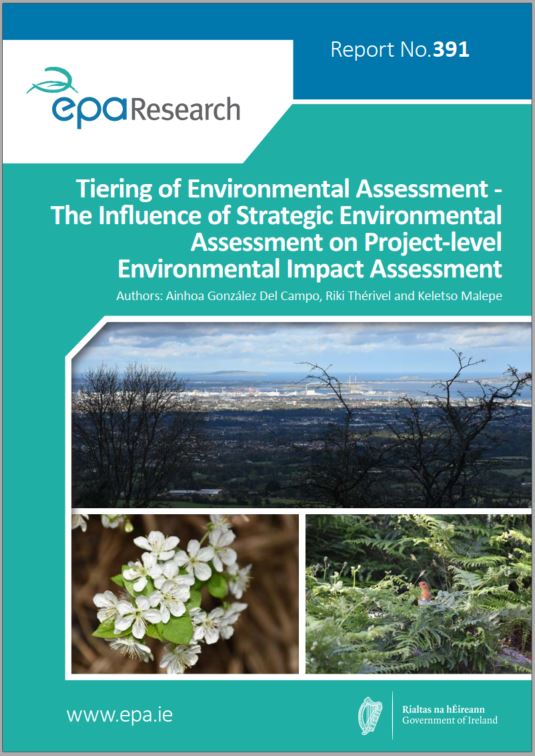Research 391: Tiering of Environmental Assessment – The Influence of Strategic Environmental Assessment on Project-level Environmental Impact Assessment
Authors: Ainhoa González Del Campo, Riki Thérivel and Keletso Malepe
Summary: Strategic Environmental Assessments (SEAs) aim to identify and mitigate environmental impacts resulting from the implementation of plans and programmes before they are adopted. This research was based on a literature review, interviews with 28 international and Irish experts, and a review of 19 Irish case studies. The research identified a range of good practice approaches to impact assessment tiering, which can be summarised as better communication between SEA and EIA practitioners.

Project Highlights
Watch the project highlights video
Identifying Pressures
Strategic Environmental Assessments (SEAs) aim to identify and mitigate environmental impacts resulting from the implementation of plans and programmes (e.g. county development plans, wind energy strategies) before they are adopted. Environmental Impact Assessments (EIAs) aim to do the same for projects (e.g. residential or windfarm developments) before planning permission is given. In theory, SEAs should set the context for, and inform, EIAs so that environmental considerations trickle down for environmental protection on the ground. EIAs could also provide data for SEAs, enhancing the evidence-base for strategic assessments and decisions. However, in practice, the lack of communication and links between SEA and EIA impede achieving the benefits of tiering.
This research was based on a literature review, interviews with 28 international and Irish experts, and a review of 19 Irish case studies. It found that SEA data are rarely used in EIAs; SEA alternatives are sometimes referred to in EIAs but could set a clearer structure; SEA mitigation measures are generally not written with EIAs in mind; and EIA monitoring does not feedback to SEAs. This reduces the effectiveness and efficiency of both SEAs and EIAs.
Informing Policy
Improving impact assessment tiering involves better communication: writing SEAs with EIAs in mind and referring to SEAs in EIA Reports. This allows strategic-level alternatives and public concerns to be addressed at the strategic scale, so that these issues do not need to be revisited for each subsequent project. It allows urgent issues such as climate change and biodiversity loss, which require a strategic response, to be better considered in individual projects. It can allow strategic decisions for large-scale development to be made early on – for instance protecting strategic development sites from inappropriate development. SEA may also be able to define the scope of subsequent EIAs, saving time and resources. Although this all involves more work at the SEA stage, it can reduce the workload at the EIA stage, and help to ensure that plans and environmental objectives are better implemented. However, some institutional issues can set a context that restricts tiering, including ‘silo assessment’ and lack of training.
Developing Solutions
This research has identified a range of good practice approaches to impact assessment tiering, which can be summarised as better communication between SEA and EIA practitioners. Data can be better shared, for instance by using GIS. Planners and SEA practitioners should undertake their SEAs and write their plans and SEA reports with lower-tier assessments in mind, and provide clearer guidance, mitigation and data acquisition/monitoring recommendations for lower tiers, including projects and their EIAs. EIAs should align with higher-tier SEAs by checking that all key issues are addressed, data gaps are filled, proposed alternatives take into account strategic choices, and relevant SEA mitigation measures are integrated into the EIA process, the project and associated documentation.
Related Publications
Research 392: Guidance on Strategic Environmental Assessment–Environmental Impact Assessment Tiering
https://www.epa.ie/media/epa-2020/research/epa-funded-research/Report-cover-391.jpg